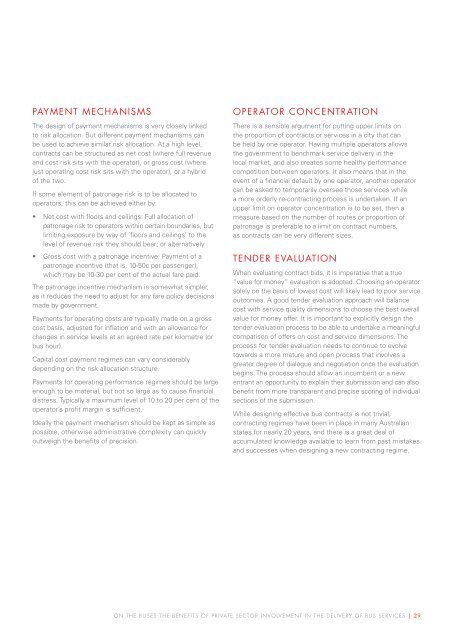ON THE BUSES
TTF-On-The-Buses-Report-2016
TTF-On-The-Buses-Report-2016
You also want an ePaper? Increase the reach of your titles
YUMPU automatically turns print PDFs into web optimized ePapers that Google loves.
PAYMENT MECHANISMS<br />
The design of payment mechanisms is very closely linked<br />
to risk allocation. But different payment mechanisms can<br />
be used to achieve similar risk allocation. At a high level,<br />
contracts can be structured as net cost (where full revenue<br />
and cost risk sits with the operator), or gross cost (where<br />
just operating cost risk sits with the operator), or a hybrid<br />
of the two.<br />
If some element of patronage risk is to be allocated to<br />
operators, this can be achieved either by:<br />
• Net cost with floors and ceilings: Full allocation of<br />
patronage risk to operators within certain boundaries, but<br />
limiting exposure by way of ‘floors and ceilings’ to the<br />
level of revenue risk they should bear; or alternatively<br />
• Gross cost with a patronage incentive: Payment of a<br />
patronage incentive (that is, 10-50c per passenger),<br />
which may be 10-30 per cent of the actual fare paid.<br />
The patronage incentive mechanism is somewhat simpler,<br />
as it reduces the need to adjust for any fare policy decisions<br />
made by government.<br />
Payments for operating costs are typically made on a gross<br />
cost basis, adjusted for inflation and with an allowance for<br />
changes in service levels at an agreed rate per kilometre (or<br />
bus hour).<br />
Capital cost payment regimes can vary considerably<br />
depending on the risk allocation structure.<br />
Payments for operating performance regimes should be large<br />
enough to be material, but not so large as to cause financial<br />
distress. Typically a maximum level of 10 to 20 per cent of the<br />
operator’s profit margin is sufficient.<br />
Ideally the payment mechanism should be kept as simple as<br />
possible, otherwise administrative complexity can quickly<br />
outweigh the benefits of precision.<br />
OPERATOR C<strong>ON</strong>CENTRATI<strong>ON</strong><br />
There is a sensible argument for putting upper limits on<br />
the proportion of contracts or services in a city that can<br />
be held by one operator. Having multiple operators allows<br />
the government to benchmark service delivery in the<br />
local market, and also creates some healthy performance<br />
competition between operators. It also means that in the<br />
event of a financial default by one operator, another operator<br />
can be asked to temporarily oversee those services while<br />
a more orderly re-contracting process is undertaken. If an<br />
upper limit on operator concentration is to be set, then a<br />
measure based on the number of routes or proportion of<br />
patronage is preferable to a limit on contract numbers,<br />
as contracts can be very different sizes.<br />
TENDER EVALUATI<strong>ON</strong><br />
When evaluating contract bids, it is imperative that a true<br />
“value for money” evaluation is adopted. Choosing an operator<br />
solely on the basis of lowest cost will likely lead to poor service<br />
outcomes. A good tender evaluation approach will balance<br />
cost with service quality dimensions to choose the best overall<br />
value for money offer. It is important to explicitly design the<br />
tender evaluation process to be able to undertake a meaningful<br />
comparison of offers on cost and service dimensions. The<br />
process for tender evaluation needs to continue to evolve<br />
towards a more mature and open process that involves a<br />
greater degree of dialogue and negotiation once the evaluation<br />
begins. The process should allow an incumbent or a new<br />
entrant an opportunity to explain their submission and can also<br />
benefit from more transparent and precise scoring of individual<br />
sections of the submission.<br />
While designing effective bus contracts is not trivial,<br />
contracting regimes have been in place in many Australian<br />
states for nearly 20 years, and there is a great deal of<br />
accumulated knowledge available to learn from past mistakes<br />
and successes when designing a new contracting regime.<br />
<strong>ON</strong> <strong>THE</strong> <strong>BUSES</strong>:<strong>THE</strong> BENEFITS OF PRIVATE SECTOR INVOLVEMENT IN <strong>THE</strong> DELIVERY OF BUS SERVICES | 29


